Red harvester ants are persistent pests that can inflict painful bites and damage your property. Unlike fire ants (which they’re often mistaken for), red harvester ants are a distinct species that forage non-stop for seeds and greens while creating massive mounds on your property. This comprehensive guide will show you how to identify, control, and completely how to get rid of red harvester ants from your home and yard.
Quick Picks: How to Get Rid of Red Ants Effectively
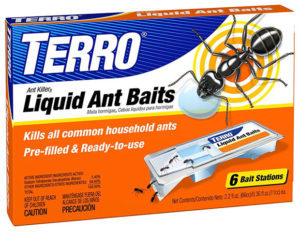
Editor’s Choice
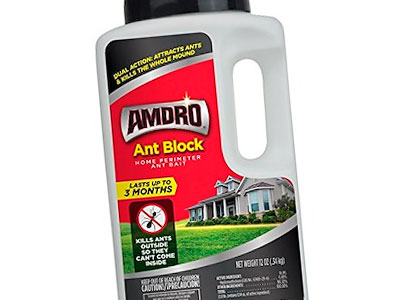
Best for Perimeters

Most Effective
How to Identify Red Harvester Ants
Before you start treating your property, you need to be certain you’re dealing with red harvester ants rather than other ant species.
Physical Characteristics
- Relatively large ants (¼ to ½ inch long)
- Color ranges from red to dark brown
- Elongated bodies with squarish heads
- No spiny bodies (unlike some other ant species)
Habitat Signs
- Large mounds (up to 50 inches in diameter)
- Areas around mounds stripped of vegetation
- Long, visible ant trails spiraling out from the mound entrance
- Distinctive smell on their trails (if you have a keen sense of smell)
Behavior Patterns
- Extremely aggressive when disturbed
- Inflict painful, burning bites
- Forage constantly for seeds and plant materials
- “Hill-topping” behavior during mating seasons
During summer rainstorms, you may witness thousands of red ants swarming your property. Male swarmers are larger than workers and have wings. This swarming typically occurs on a single day and presents an excellent opportunity to control their population if you’re prepared with the right pesticides.
What Do Red Harvester Ants Eat?
While their painful bites might make you think they’re after you, red harvester ants primarily feed on:
- Sunflower seeds
- Wildflower seeds
- Grass seeds
- Clover heads
- Alfalfa
They’ll also occasionally eat other insects for protein. Red harvester ants are industrious foragers that can significantly reduce crop yields in farm fields and rangelands. Interestingly, research has shown these ants often wait for seeds to germinate before eating the tender sprouts, essentially practicing farming themselves!
Red Harvester Ants vs. Other Common Ant Species
| Feature | Red Harvester Ants | Fire Ants | Carpenter Ants |
|---|---|---|---|
| Size | ¼ to ½ inch | ⅛ to ¼ inch | ¼ to ½ inch |
| Color | Red to dark brown | Reddish-brown | Black to reddish |
| Nest Type | Large mounds with cleared area | Irregular mounds with multiple openings | Wood galleries, no visible mound |
| Diet | Seeds and plants | Protein and sweets | Sugars and proteins |
| Damage Type | Yard/landscape damage | Painful stings, yard damage | Structural wood damage |
5-Step Guide to Get Rid of Red Harvester Ants
Eliminating red ants requires a systematic approach. Follow these five steps to effectively rid your property of these persistent pests. Start by identifying the source of the infestation and sealing any entry points to prevent further access. Next, use bait traps and natural repellents to target the colony directly. If you’re also dealing with other pests, researching how to get rid of carpenter ants can provide additional insights into effective pest control strategies.
Step 1: Identify the Ants
As we’ve covered above, proper identification is crucial. Red harvester ants require specific treatments due to their size and colony structure. Verify you’re dealing with red harvester ants by looking for their characteristic mounds, trails, and physical features.
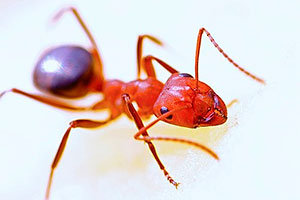
Step 2: Do a Major Clean-Up
Making your property less hospitable to ants is an essential part of control. Focus on eliminating attractants and hiding places:
- Remove debris, garbage, and clutter from your yard that might provide shelter
- Fix leaking outdoor faucets, hoses, or sprinklers and eliminate standing water
- Secure pet food and human food, including better positioning of garbage cans
- Cut tall grass near structures and move mulch and plants away from foundations
While natural predators like the Texas horned lizard can help control ant populations, you’ll likely need to take more direct action for an existing infestation.
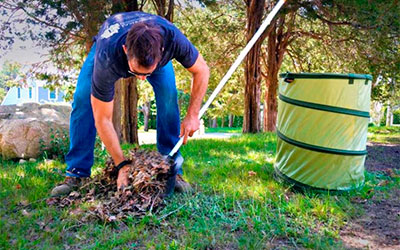
Step 3: Using Ant Control Products
A multi-faceted approach works best. Use a combination of products strategically placed where ants are active:
- Place gel baits where ants congregate
- Apply granular baits along walls where ants trail
- Keep spray products handy for immediate spot treatments
Here are detailed looks at the most effective products for red harvester ant control:
TERRO Liquid Ant Baits
Editor's ChoiceHow Does It Work
How to Use
- Place bait stations near visible ant trails and areas where ants enter your home
- For indoor use, position near corners, along walls, and close to entry points
- For outdoor use, place stations near anthills and foundation edges
- Replace when empty or every three months
- Highly attractive formula that ants can't resist
- Eliminates the entire colony, including the queen
- Ready-to-use with no mixing required
- Transparent design for easy monitoring
- Liquid can spill if stations are knocked over
- May take 1-2 weeks for complete colony elimination
- Needs to be kept away from pets and children
Amdro Ant Block Granules
Best for PerimetersHow Does It Work
How to Use
- Sprinkle granules around the perimeter of your home, creating a 3-foot band
- Apply directly to ant mounds, using more product for larger mounds
- Reapply after heavy rain or every 3 months
- Keep pets and children away from treated areas until granules are watered in
- Creates an effective barrier against invading ants
- Kills multiple ant species, including harvester ants
- One application lasts up to 3 months
- Easy to apply with the shaker container
- Not suitable for use directly in gardens with edible plants
- Needs to be reapplied after heavy rain
- Can be harmful to beneficial insects if not applied correctly
Advance Granular Ant Bait
Most EffectiveHow Does It Work
How to Use
- Broadcast application: Spread evenly over infested area at a rate of 1-1.5 pounds per acre
- Mound treatment: Apply 1-3 tablespoons around each mound
- For household perimeters: Apply in a band 1-2 feet wide around foundation
- Reapply every 6-8 weeks as needed
- Highly effective against harvester and other hard-to-kill ant species
- Professional-grade formula used by exterminators
- Weather-resistant granules remain effective longer
- Low amount needed per application
- More expensive than some consumer-grade options
- Must be kept absolutely dry for maximum effectiveness
- Not suitable for use around edible plants
Other Effective Products
- Diatomaceous Earth: Safer Brand Diatomaceous Earth dehydrates ants by damaging their exoskeletons. Dust it on trails and anthills.
- Ant Spray: Raid Ant & Roach Killer provides immediate results for visible ants. Use for spot treatments when you need quick action.
Step 4: Seal Off Entry Points
Preventing ants from entering your home is crucial for long-term control:
- Inspect your foundation for cracks and seal them with caulk
- Check windows and doors for gaps and install weatherstripping if needed
- Examine areas where pipes and wires enter your home and seal openings
- Repair damaged screens on windows and vents
Sealing entry points not only keeps new ants out but also makes it easier to treat those already inside.

Step 5: Find Outdoor Ant Hills and Eliminate the Colony
The ultimate goal is to completely eliminate the colony, including the queen. Red harvester ants typically build their nests in soil with easy access to water and will travel along established trails. Look for these trails along foundations or sidewalks to locate the main colony.
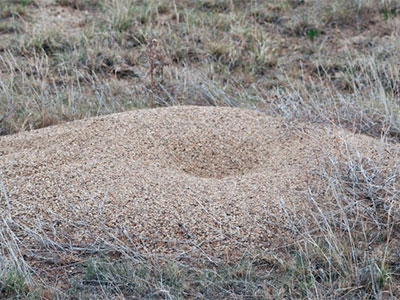
Most Effective Methods for Outdoor Colony Elimination:
- Direct Mound Treatment: Apply insecticides directly onto ant mounds and the immediately surrounding area for maximum effectiveness.
- Bait Placement: Position granular baits or liquid baits near the nest and along major ant trails. The workers will carry the poison back to the colony.
- Plant Protection: Mix flour with baking soda and dust the base of plants that ants frequent. The baking soda is toxic to ants.
- Dehydration: Apply diatomaceous earth to ant trails. The ants will carry it back to the colony where it will cause fatal dehydration.
- Boiling Water Method: After rain when tunnels are muddy, pour 2-3 gallons of boiling water into each anthill. Use caution with this method to avoid burns.
Red harvester ants primarily live outdoors, but winged swarmers may enter your home during mating season. If anthills are near your foundation or in nearby gardens, the workers may forage inside your home. Finding and eliminating these outdoor colonies is the key to preventing indoor invasions.
Regional Guide to Red Harvester Ant Control
Red harvester ants are not evenly distributed across the United States. Their prevalence and behavior vary significantly by region, requiring different control approaches based on your location:
| Region | Prevalence | Specific Challenges | Recommended Approaches |
|---|---|---|---|
| Southwest (TX, AZ, NM, NV) |
Very High |
|
|
| Western States (CA, OR, WA, CO, UT) |
Moderate to High |
|
|
| Great Plains (OK, KS, NE, SD) |
Moderate |
|
|
| Southeast (Parts of LA, AR) |
Low to Moderate |
|
|
| Other Regions | Very Low |
|
|
Understanding regional differences can significantly improve your control efforts. In high-prevalence regions, more aggressive and consistent treatment approaches are typically necessary, while in marginal regions, careful identification and targeted treatments are more appropriate.
Preventing Future Red Harvester Ant Infestations
After successfully eliminating red harvester ants from your property, implementing preventative measures is crucial to avoid reinfestation. Here’s a comprehensive approach to keeping these pests away for good:
Landscape Management
- Maintain a 12-18 inch gravel barrier around your home’s foundation
- Trim vegetation away from your house, keeping a gap of at least 2 feet
- Remove leaf litter, mulch piles, and other organic debris regularly
- Consider xeriscaping in highly prone areas, as harvester ants prefer open, sunny areas
Seasonal Maintenance
- Schedule quarterly perimeter treatments, especially before summer rainy seasons
- Apply preventative granular treatments in early spring before colonies establish
- Inspect your property monthly during warm seasons for signs of new colonies
- Treat small mounds immediately upon discovery to prevent establishment
Home Protection
- Maintain sealed entry points, inspecting caulking and weatherstripping annually
- Keep food sources secured in airtight containers
- Repair any water leaks promptly, as moisture attracts ants
- Consider professional preventative treatments if you live in a high-risk area
For properties in areas with recurring infestations, consider establishing a regular treatment schedule with a professional pest control service. Many offer quarterly maintenance programs specifically designed to prevent harvester ants and other seasonal pests.
Conclusion
Red harvester ants can be persistent pests, but with systematic treatment and prevention measures, you can successfully eliminate them from your property. The key is to identify them correctly, use multiple control methods simultaneously, seal entry points, and most importantly, locate and destroy their colonies.
For the best results:
- Confirm you’re dealing with red harvester ants by identifying their physical characteristics and mound structure
- Clean your property to remove attractants and hiding places
- Apply appropriate bait products that target the entire colony
- Seal all entry points to prevent ants from entering your home
- Locate and treat outdoor colonies to eliminate the source of the problem
If your red ant infestation persists despite these efforts, don’t hesitate to consult professional pest control services, who have additional tools and expertise to handle stubborn infestations.
Frequently Asked Questions About Red Harvester Ants
How dangerous are red harvester ants?
Red harvester ants can deliver painful, burning bites that are often mistaken for fire ant stings. Their venom is potent and can cause intense localized pain, swelling, and itching that may last for several hours. While not typically life-threatening, their bites can be particularly uncomfortable.
For most people, red harvester ant bites require only basic first aid. However, individuals with known insect allergies should exercise caution, as severe allergic reactions are possible. If you experience difficulty breathing, severe swelling, or other signs of an allergic reaction after being bitten, seek medical attention immediately.
How long does it take to eliminate red harvester ant colonies?
The time frame for eliminating red harvester ant colonies varies depending on the method used:
- Direct mound treatments with insecticides can kill visible ants within hours, but complete colony elimination may take 1-2 days
- Bait systems typically take 5-10 days to show significant reduction in ant activity
- Complete colony elimination with baits usually requires 2-3 weeks as the poison must reach the queen and all members of the colony
- Boiling water method can kill many ants immediately but may require 2-3 applications for complete elimination
For large infestations with multiple colonies, the process may take longer, sometimes requiring 4-6 weeks of consistent treatment to completely eradicate all colonies on your property.
How do I distinguish red harvester ants from fire ants?
While both can inflict painful bites, red harvester ants and fire ants have several distinguishing features:
- Size: Red harvester ants are larger (¼ to ½ inch long) compared to fire ants (⅛ to ¼ inch)
- Mounds: Harvester ant mounds are larger (up to 50 inches in diameter) with a distinct cleared area around them, while fire ant mounds are smaller and often have multiple openings
- Body shape: Harvester ants have squarish heads and a more uniform body segment size, while fire ants have heart-shaped heads
- Behavior: Harvester ants follow distinct trails and forage for seeds, while fire ants are more erratic in movement and aggressive when disturbed
- Habitat: Harvester ants prefer dry, desert-like conditions and are common in the Southwest, whereas fire ants thrive in more humid environments
Both species can inflict painful bites, but fire ants tend to attack in greater numbers when their nest is disturbed.
Are natural remedies effective against red harvester ants?
Natural remedies can provide varying levels of effectiveness against red harvester ants:
- Diatomaceous earth: Moderately effective; dehydrates ants but works slowly and may require multiple applications
- Boiling water: Effective for immediate killing but may not reach deep enough to eliminate the queen
- Vinegar solution: Limited effectiveness; works as a temporary repellent but doesn’t eliminate colonies
- Essential oils: Peppermint, tea tree, and citrus oils can deter ants but rarely eliminate established colonies
- Baking soda mixed with powdered sugar: Can be toxic to ants but has limited effectiveness against large colonies
For small infestations, natural remedies may provide adequate control. However, for large established colonies, commercial products typically offer more reliable and complete elimination.
Will killing one colony prevent future red ant infestations?
Eliminating a single colony will not necessarily prevent future infestations. Red harvester ants reproduce through mating flights, with queens capable of flying considerable distances to establish new colonies. Additionally, your property may have multiple colonies that aren’t immediately visible.
For long-term prevention, you should:
- Maintain regular perimeter treatments around your property
- Address environmental factors that attract ants (moisture, food sources, shelter)
- Monitor your property regularly, especially after summer rains when new colonies might form
- Implement preventative treatments during peak swarming seasons (typically after summer rains)
A comprehensive approach to prevention is more effective than simply reacting to visible colonies as they appear.
When should I call a professional exterminator for red ants?
Consider consulting a professional exterminator in these situations:
- When you have multiple large colonies that DIY methods haven’t effectively controlled
- If red ants are consistently entering your home despite your prevention efforts
- When colonies are in difficult-to-reach areas or near structural elements of your home
- If you or family members have allergic reactions to ant bites
- When infestations return repeatedly despite thorough treatment
- If you need to treat large areas (over an acre) where colonies are widespread
Professional exterminators have access to commercial-grade products and equipment not available to consumers, as well as the expertise to identify the most effective treatment strategy for your specific situation.
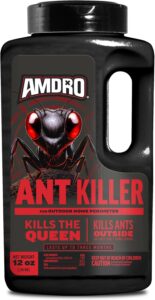

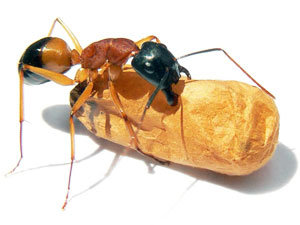
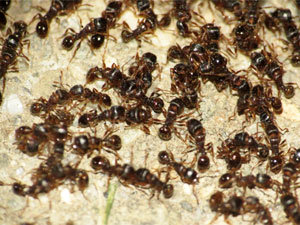

I dont know where you get your information, but half of what you say about red harvester ants is untrue. They are absolutely not aggressive, you can practically stand in their bed and not get bitten. They do have a painful bite, but you have to really put them in a bind to find out. Red ants do not typically invade your house, nor reside under debris. They prefer open pasture. Fire ants ran them completely from my place for years so I was excited to see them make a comeback. Where they are, fireants arent, so I welcome their mounds. They are interesting creatures to watch and now that they are back, maybe I will see a horned lizard(horny toad) once again.
I tried th Terro ant bait packets and the ants avoided them like the plague-would not go near them!